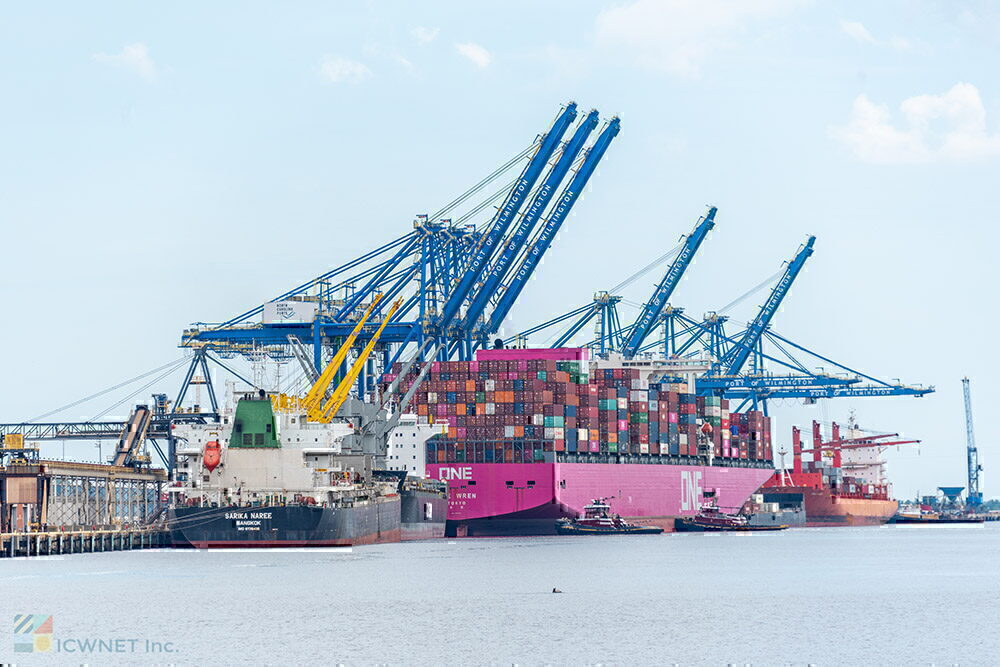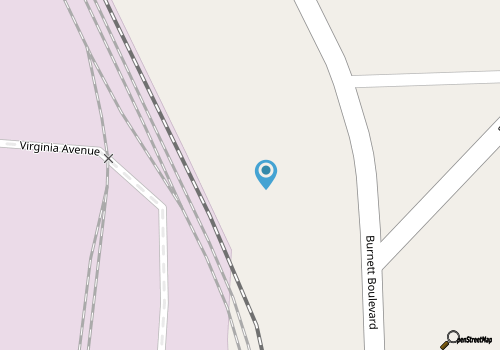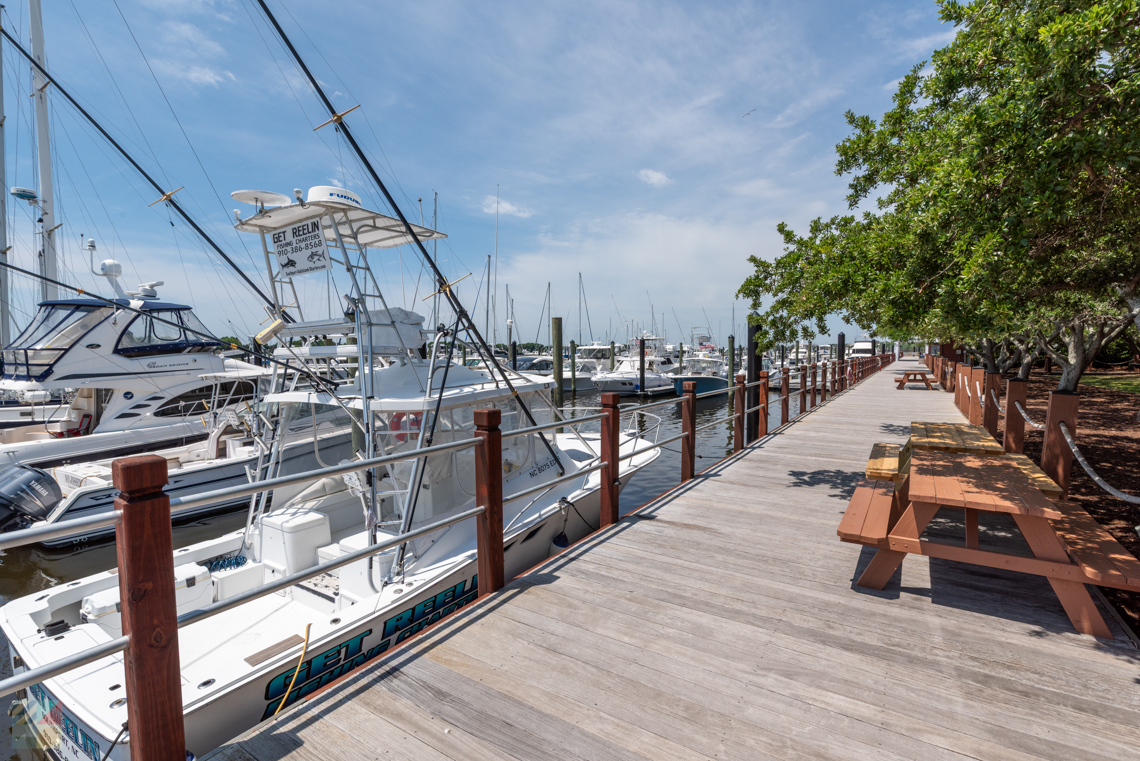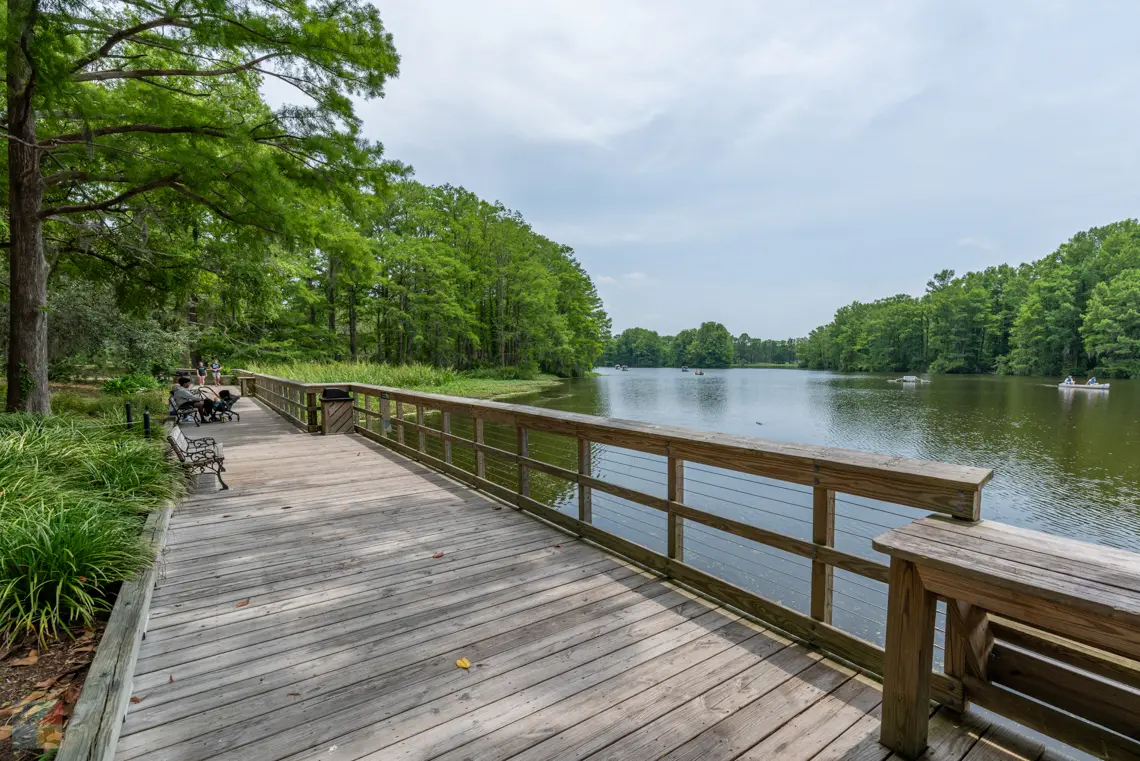
Though the Port of Wilmington is a comparatively new landmark in this centuries-old city, it is nevertheless a fixture along the downtown waterfront, and an integral aspect of the region’s economic success. An unmistakable sight along the Cape Fear River that can be viewed from miles away, this busy commercial port is often humming with activity, from the large container ships that ease in and out of the 42-foot-deep channel, to the towering warehouses that serve as the launching points for international trade.
The Port of Wilmington may be an industrial site that is rarely frequented by everyday tourists, but the scale and visibility of the port makes it a part of every downtown visit. In addition, with centuries-old roots that helped create the formation of the “Port City” to begin with, the Port of Wilmington is an instrumental component of what makes this costal community so unique in the state of North Carolina.
The rise of the Port City
While today’s Port of Wilmington is easily accessible by vessels of all sizes, the Cape Fear River initially earned its name for the rough waters and foreboding shoals that explorers encountered roughly 500 years ago.
The area was initially discovered by Europeans in 1524, (and specifically by the explorer Verrazano under the direction of the King of France), but the region wasn’t permanently settled until the formation of “Brunswick Town,” a site that’s located south from the current Port of Wilmington, and which served as the first capital of the colony of North Carolina.
Situated in a relatively protected stretch of the Cape Fear River, the original Brunswick Town settlement quickly became one of the leading seaports in the state, and throughout the southeast coastline.
As a result of this success, Wilmington became known as a center of trade, politics, and culture of the Colonial Era and beyond, and the “Port City” moniker soon followed. This prosperity was directly connected to the location and layout of the Cape Fear River, as goods could easily be transported inland, and/or exported to international ports-of-call in England, as well as other countries throughout Europe.
During the Civil War - and thanks to the strength of nearby Fort Fisher - Wilmington also remained an operational port community for the bulk of the war years, and was the last Atlantic Coast port of the Confederacy to remain open to trade. Fort Fisher would eventually fall to Federal troops during the largest naval bombardment of the war, (and the 19th century in general), on January 15, 1865, but after a brief period of economic depression and recovery, Wilmington once again regained its status as a center of commerce, and as the state’s primary launching point for importing/exporting goods around the world.
In the early 1920s, North Carolina Governor Cameron Morrison started to float the idea of developing official port facilities within the state, and was a key player in creating the State Ship and Water Transportation Commission (SSWTC). The SSQTC’s mission was to study the options for developing docks, wharves, terminals, and other facilities to enhance on-the-water commerce, and the ensuing report found that an initiative to develop these facilities was not only achievable, but would be a huge financial asset to the state.
The SSQTC was replaced by the Ports Commission a year later in 1924, which immediately went to work on creating these port facilities, but their efforts to secure $8.7 million from the state to develop these ports failed on the ballot, and the endeavor was put on the backburner for the next 10 years.
Despite the statewide setback, both Wilmington and Morehead City embarked on their own efforts to enhance their ports, and these local efforts led to the creation of the Wilmington Port Commission by the North Carolina General Assembly in 1935.
In 1945, the North Carolina State Ports Authority was established, with the sole goal of creating and improving harbors at Morehead City, Southport, and the state’s first “Port City,” Wilmington.
The construction of two state facilities in Morehead City and Wilmington began simultaneously in 1949 with $7.5 million in funds, and the projects were both completed in 1952.
The current State Port at Wilmington was officially dedicated on September 18, 1952, and opened with a 1,510-foot wharf, two transit sheds with a capacity of 158,000 square feet, and a storage warehouse of 86,100 square feet.
In the past 70 years, the Port of Wilmington has continually grown in scale and amenities, in order to accommodate the shipping and trade needs of coastal North Carolina, and hundreds of miles beyond.
The Port of Wilmington Today
The Port of Wilmington is located 26 miles from the open Atlantic Ocean waters on the Cape Fear River, and the complex boasts a 42-foot-deep channel, a 600,000 TEU capacity container terminal, seven container cranes, and almost one million square feet of covered storage space.
Connecting with the railway for easy transportation, the Port of Wilmington’s strategic location means that it is within 700 miles of more than 70% of the U.S. industrial base.
The Port of Wilmington is one of the few ports in the Southeast United States with readily available berths and storage areas for containers and general cargo of all varieties, and the terminal serves container, bulk, breakbulk, and ro-ro operations. With its connection to CSX Transportation and rail service, (as well as access to two of the East Coat’s busiest roadways - Interstates 95 and 40), the port remains one of the busiest launching points for international trade for the Southeast U.S. market.
There are a number of products that arrive and depart from this Wilmington location, including grains, chemicals, furniture, apparel, and automotive parts. Most significantly, the port has been a longstanding hub for wood products and lumber, which has been a primary good that has been imported and exported out of the Port City for hundreds of years.
There are two main entrances to the Port of Wilmington – the Container Terminal and General Cargo Terminal – which connect with the waterfront, and the site’s 6,768 feet of wharf frontage.
Accessing or Visiting the Port of Wilmington
Currently, there are no public tours of either of North Carolina’s State ports in Morehead City and Wilmington, however, visitors who need access to any North Carolina Ports facility can request an escort from the state in advance.
To request port access to the Port of Wilmington, potential visitors will need to fill out a NCSPA Port Access Application to gain entrance to any of the port’s facilities.
While no tours are available, the industrial nature of the site makes the Port of Wilmington an unlikely and unappealing tourist destination, but visitors can nevertheless take in the expansive views of the sprawling site, which are a fixture in the downtown landscape.
Visitors will see the port crossing the Cape Fear River into the downtown area from virtually every route, (and namely US 17 Business), and folks can catch an even closer view by going to the southern corners of the downtown area, close to Greenfield Lake and the Wilmington Railroad Terminal.
Scenes of the Port of Wilmington are also captured and celebrated throughout the city, in artworks, photos, and other wares in local galleries and museums. A good starting point to dive deeper into the Port City’s history as a major trade destination is the Cape Fear Museum of History and Science, which is conveniently located at 14 Market Street in downtown Wilmington.
The Port of Wilmington is by no means a popular tourist attraction, but its stature as a hub of international trade and commerce has helped keep the city thriving for decades.
An unmissable site along the Cape Fear waterfront, the Port of Wilmington is an unmistakable and essential addition to this busy coastal community which has been an economic success story for centuries.
Is this your business? Update your listing by messaging us
With a location on the edge of the Intracoastal Waterway, the Cape Fear River, the Elizabeth River, and even the Atlantic Ocean, Southport is a paradise for mariners. The town and the surrounding area is stocked with unique shops, restaurants, and attractions that are a shell’s throw away from the local docks, and which can accommodate the array of mariners who are cruising through or dropping anchor for the long haul. Regardless of whether a visitor wants to cruise the waters for days at a time, or just enjoy a ride while staying in the area on vacation, Southport delivers with ample options. Make the most out of a waterfront getaway, and discover all the ways why this region and boating seamlessly go hand in hand.
Greenfield Lake Park is known as one of Wilmington’s coolest and most scenic destinations, and is a vast public park that’s located just south of the historic downtown area. Located on the western edge of Greenfield Lake, and just a stone’s throw from the Cape Fear Riverfront, this pretty public park is the perfect spot for hikers, birdwatchers, kayakers, and anyone who appreciates a natural vista to take a break from the bustling city and simply unwind.
Dogs Accepted at Slack Tide luxury home in Carolina Beach UnitsRents Saturday to Saturday for weekly stays 5 Bedroom / 5 Bath / Sleeps 11 Our premiere, newly constructed, bespoke-constructed home features a brand new private backyard pool and hot tub shared with the duplex next door. Unwind in your lounge chair under the palm trees at the pool with a Mai Tai and a good book. Or, walk effortlessly from our impressive home just a one-block walk to the Oyster Shell public beach access for a day of fun. On the street side of our home, you will delight in a incredible view of the Carolina Beach canal and marina from every window and deck. We are steps away from Carolina Beach Mooring Field's dinghy dockand the North End Mini Mart Cafe. So, take a break from your sailing cruise: get your sea legs back in luxury at Slack Tide. Your friends can moor close by and join you for a bit of comfort with multiple bedrooms, private balconies, and bathrooms accepting you all the great rest and privacy you need. Bring the family: Slack Tide has Infant Equipment, Beach Toys, and Roku intelligent TVs in every bedroom. You can even bring your furry friend: Beach Life doesn't get any better than this!Ground Level:Covered parking under the home for up to 3 cars, size dependent. Driveway parking for one or two smaller cars. This is a shared drive entrance: do not block the neighbor. Pool with hot tub. Pool furnishings for dining, sitting, and calming. Outdoor private shower, Stairwell to deck or entrance. Elevator.Beach chairs and body boards. Level 2:Canal/Island view front porch: 2 Adirondack chairs Guest Bedroom 1: Twin/Full Bunk Bed, Intelligent TVGuest Bathroom 1: Jack and Jill Bathroom with Bathtub and ShowerGuest Bedroom 2: Queen bed, Intelligent TVGuest Bedroom 3: Queen Bed, Deck Access, En suite BathroomEnsuite Bathroom: Walk In ShowerStairwell to Mid Level BedroomsLevel 3:Primary Bedroom Suite 1: King Bed, Intelligent TV, Ensuite Bathroom with Walk-in shower, double vanityPrimary Bedroom Suite 2: King Bed, Intelligent TV, Ensuite Bathroom with Shower/tub combo Laundry Closet with Washer/DryerOceanview Deck: 2 Adirondack chairs, Modest tableCanal view Deck: 2 Adirondack chairsLevel 4:Living Area: Intelligent TV, Couch, 2 Cushioned chairs, 2 Rocking chairs, Deck AccessLiving Area Deck: Canal View Dining Area: Table with seating for 10Dining Area Oceanview Deck: 2 Adirondack chairs, Modest table Kitchen: Entirely equipped, Stainless steel appliances, Bar seating for 6Half BathParking:4 dedicated parking spots below the unitLinens - Beds will be made with clean sheets, bath towels will be laying on the end of the beds, bathmats supplied in each bathroom, kitchen towel and dish sponge included. (Guest will need to make any trundle, couch beds, or top bunk beds.) Rental Policies:In response to the increased incidence of credit card fraud, a valid government photo ID will be required for every reservation. A signed rental agreement is required: accepting House Rules on any online travel agency requires reading and acceptance of our rental agreement.Things to bring:Paper towels and toilet paper, trash bags, soaps, detergents, minimal cleaning supplies, and beach towels.Arrival/Departure:Summer Check-ins (June-August) begin at 4 pm and are guaranteed by 6 pmOff Season Check-ins begin at 3 pm and are guaranteed by 5 pmCheck-out is by 10 am. We adhere to this policy so please do not arrive early or plan to delay your departure.Guest Access:Electronic Entry.House Rules:No events such as weddings, bachelor/bachelorette events, sororities/fraternities No smokingYou must be at least 25 to rent this unit.Elevator Policies:Please note, the elevator is for convenience only and does not guarantee ADA Compliance or Wheelchair accessibility. Although elevators are checked on a regular basis, Sea Coast Units/Owners will not be held accountable if the elevator is not operating or functioning properly during your stay. No refunds will be issued for these closures. Pool Notice:Pools are generally open from Memorial Day until Labor Day; however, pool closures may be dictated by the HOA or the Health Department. Pools may also be closed after a hurricane or tropical storm. Sea Coast Units/Owners will not be held accountable. No refunds will be issued for these closures.Pet Policy:Dogs Accepted. The first dog is supplied in the price of the Rental. Subsequent dogs are subject to an additional payment and restrictions! Carolina and Kure Beaches are pet-friendly, but you must follow town guidelines. Please check the town website for beach pet restrictions.Cancellation Policy:- Free cancellation within 48 hours of booking- After 48 hours of booking and more than 60 days out from arrival, a full refund will be processed less a $300 cancellation debit.- After 48 hours of booking and within 60 days of arrival, there will be no refund processed unless the dates are re-rented. If premises are re-rented, a refund will be processed less a $300 cancellation debit.Things to do:Adventure awaits. Discover aquatic wildlife and vegetation at the North Carolina Aquarium at Fort Fisher or savor a relaxing ferry ride across the Cape Fear River to a cozy little shopping town called Southport. Take a trip back in time at the Fort Fisher State Historic Site and Museum which features live oak-covered trails and bunkers from the American Civil War. Stroll through the marsh to visit the home of the famed Ft. Fisher Hermit. Or wind down with nature at our two state parks, sure to provide a memorable experience with hiking, fishing, and water activities such as paddle boarding and kayaking, and search for a Venus Flytrap which is native to NC only. As one of North Carolina's most undeveloped beaches, the island offers a unique opportunity to see many diverse coastal wildlife, including pelicans and loggerhead sea turtles, in their natural habitat. Whether it’s exploring activities on the island, appreciating the ocean vistas, or enjoying a beverage by sunset from your own private balcony, Pleasure Island offers diversion for every enthusiast!Explore the treasures of Carolina Beach, ranked one of the top 10 boardwalks in the country by Food & Wine magazine. One of the last remaining beach boardwalks on the East Coast, it includes a variety of eateries, an arcade, stores, ice cream, Famous Britts Donuts, bars, and more! During the summer months, the Boardwalk is bustling with the sound of music, carnival rides, bingo, family nights, and events like the weekly fireworks and concert series. Rent a Jeep, bicycle, or golf cart as the most convenient ways to navigate the island. Annual off-season events include the Cape Fear Kite Festival, Christmas by the Sea, and the Island of Lights Festival.We look forward to you visiting us!
- Carolina Beach
- 5 Bedrooms
- 4 Bathrooms
- Sleeps 11



